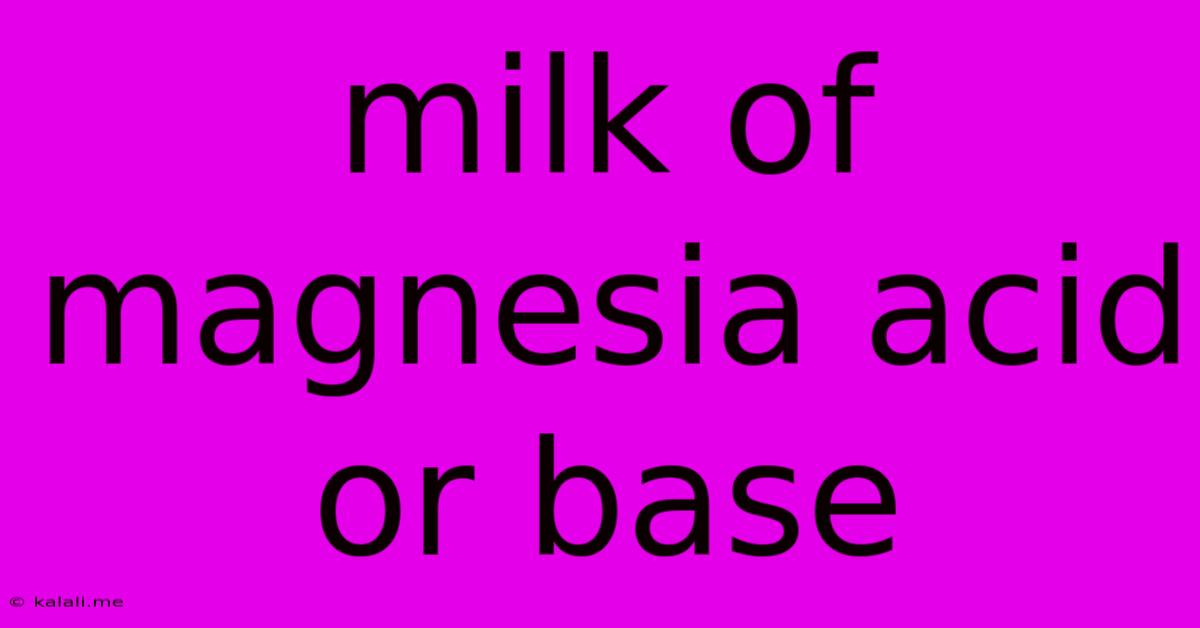Milk Of Magnesia Acid Or Base
Kalali
Jun 14, 2025 · 3 min read

Table of Contents
Milk of Magnesia: Acid or Base? Understanding its Chemical Nature
Milk of Magnesia, a common over-the-counter remedy for heartburn and constipation, is often a source of confusion when it comes to its chemical nature. Is it an acid or a base? This article will delve into the chemical composition of Milk of Magnesia, explaining its properties and clarifying its role in neutralizing stomach acid.
What is Milk of Magnesia? Milk of Magnesia, also known as magnesium hydroxide (Mg(OH)₂), is a suspension of magnesium hydroxide in water. Its properties are key to understanding its use in treating both acidity and constipation. The key takeaway is that it is a base, not an acid.
Understanding pH and the pH Scale
Before we dive deeper, let's briefly recap the concept of pH. The pH scale measures the acidity or basicity (alkalinity) of a solution. It ranges from 0 to 14, with 7 being neutral. Solutions with a pH less than 7 are acidic, while those with a pH greater than 7 are basic or alkaline. Milk of Magnesia has a pH significantly greater than 7, firmly placing it in the alkaline range.
Milk of Magnesia as an Antacid
The primary reason Milk of Magnesia is effective in relieving heartburn is its alkaline nature. Heartburn, or acid reflux, occurs when stomach acid (hydrochloric acid, HCl) flows back into the esophagus. The basic magnesium hydroxide in Milk of Magnesia reacts with this acid, neutralizing it and alleviating the burning sensation. This neutralization reaction can be represented by the following chemical equation:
Mg(OH)₂ + 2HCl → MgCl₂ + 2H₂O
This reaction produces magnesium chloride (MgCl₂) and water (H₂O), both relatively harmless compounds.
Milk of Magnesia as a Laxative
Besides its antacid properties, Milk of Magnesia also acts as a laxative. This effect is due to its ability to draw water into the intestines, softening the stool and stimulating bowel movements. This osmotic effect is a consequence of the magnesium ions (Mg²⁺) present in the solution. The increased water content in the intestines makes the stool easier to pass, relieving constipation.
Safety and Considerations
While generally safe for occasional use, excessive consumption of Milk of Magnesia can lead to side effects like diarrhea, nausea, and abdominal cramping. Individuals with certain medical conditions, such as kidney disease, should consult a doctor before using Milk of Magnesia. Always follow the recommended dosage instructions on the product label.
Other Uses and Applications
Beyond its common uses for heartburn and constipation relief, magnesium hydroxide finds applications in various other areas, including:
- Industrial applications: It's used as a fire retardant and in the production of certain plastics.
- Cosmetics: It's sometimes included in cosmetics and personal care products.
In conclusion, Milk of Magnesia is a base, specifically magnesium hydroxide, that effectively neutralizes stomach acid due to its alkaline nature. Its dual action as both an antacid and a laxative makes it a versatile over-the-counter remedy, but it's crucial to use it responsibly and consult a healthcare professional if you have any concerns. Remember to always check the label and follow the dosage instructions carefully.
Latest Posts
Latest Posts
-
Which Of These Sentences Is Grammatically Correct
Jun 14, 2025
-
Who Established The First Psychological Laboratory
Jun 14, 2025
-
4 Wheel Drive Transfer Case Diagram
Jun 14, 2025
-
Which Of The Following Is Not A Property Of Acids
Jun 14, 2025
-
The Twinkling Of Stars Is Caused By
Jun 14, 2025
Related Post
Thank you for visiting our website which covers about Milk Of Magnesia Acid Or Base . We hope the information provided has been useful to you. Feel free to contact us if you have any questions or need further assistance. See you next time and don't miss to bookmark.